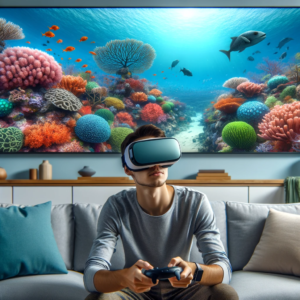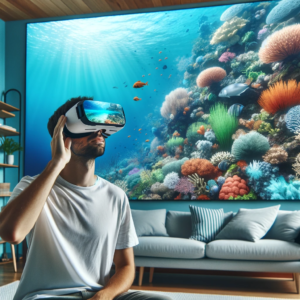Introduction
In the realm of travel, a revolutionary shift is happening. Virtual Reality (VR) is transforming the way we explore the world, offering immersive experiences without leaving the comfort of our homes. This comprehensive guide delves deep into the world of VR travel, unraveling its intricacies, possibilities, and how it’s reshaping the future of tourism.
Chapter 1: Understanding Virtual Reality in Travel
What is Virtual Reality?
Virtual Reality is a computer-generated simulation where users can interact within an artificial 3D environment using electronic devices like special goggles with a screen or gloves fitted with sensors. In travel, it means experiencing destinations in a remarkably realistic way without physical travel.
Historical Development of VR in Travel
- Early Stages: Initial concepts of VR appeared in the 1950s, with Morton Heilig’s Sensoria, an early VR machine. However, it was not until the 21st century that technology caught up with the vision.
- Recent Advancements: With the advent of sophisticated VR headsets and increasing internet bandwidth, VR travel experiences have become more accessible and realistic.

Chapter 2: The Mechanics of Virtual Reality Travel
How VR Travel Works
- 360-Degree Videos: Many VR travel experiences are built on 360-degree videos, allowing users to look around a virtual environment as if they were there.
- Interactive Elements: Some VR travels are more interactive, letting users move around and manipulate the environment.
Required Gear
- VR Headsets: From advanced headsets like Oculus Rift to simple Google Cardboard, the choice of gear varies based on quality and immersion.
- Controllers and Sensors: For a more interactive experience, additional equipment like hand controllers and body sensors are used.
Chapter 3: The Benefits of Virtual Reality Travel
Accessibility
VR travel opens up the world to people who cannot travel due to financial, physical, or other constraints, making global exploration more inclusive.
Sustainable Tourism
By providing an alternative to physical travel, VR can help reduce the carbon footprint, contributing to sustainable tourism practices.
Educational Value
VR travel is an exceptional educational tool, offering detailed, immersive experiences of historical sites, natural wonders, and different cultures.
Chapter 4: Popular VR Travel Experiences
World Landmarks
Explore wonders like the Eiffel Tower, the Grand Canyon, or the Great Wall of China in stunning detail.
Natural Wonders
Dive into the Great Barrier Reef or walk through the Amazon Rainforest with high-definition realism.
Cultural Immersion
Attend virtual cultural festivals or walk the streets of far-off cities, experiencing the sights, sounds, and even the smells.
Space Exploration
Go beyond Earth and experience what it’s like to walk on the Moon or Mars.

Chapter 5: The Challenges and Limitations of VR Travel
Technological Constraints
While technology is rapidly advancing, issues like image resolution, motion sickness, and the need for expensive equipment can be limiting.
Lack of Sensory Elements
Current VR technology primarily engages sight and sound, but other sensory elements like touch, taste, and smell are still in nascent stages.
Authenticity Concerns
Virtual experiences can lack the spontaneity and authenticity of real-world travel, missing out on unexpected encounters and the essence of being physically present.
Chapter 6: The Future of VR Travel
Technological Advancements
Future developments like improved haptic feedback, better resolution, and more immersive sensory experiences will enhance VR travel.
Integration with Other Technologies
Augmented Reality (AR), Artificial Intelligence (AI), and 5G could integrate with VR to create more seamless and interactive experiences.
Potential Market Growth
As technology becomes more affordable and widespread, the VR travel market is expected to grow exponentially, making virtual travel a common feature in many households.
Chapter 7: How to Get Started with VR Travel
Choosing the Right Equipment
Assess your budget, desired quality, and type of experience to select the right VR gear.
Finding VR Travel Content
Numerous platforms and services offer VR travel experiences – from free YouTube 360 videos to subscription-based services.
Creating Your Own VR Travel Experiences
With the right equipment and a little know-how, you can even create and share your VR travel content.
Conclusion
Virtual Reality travel is a rapidly evolving field, offering new ways to explore and understand the world. It’s an inclusive, sustainable, and exciting addition to the world of tourism and technology. As VR continues to evolve, it promises to bring the farthest corners of the world to our fingertips, transforming our travel experiences in ways we’ve only begun to imagine.
This extensive guide has just scratched the surface of what VR travel has to offer. As technology advances and becomes more accessible, the potential for growth and innovation in this field is boundless. Whether you’re a seasoned traveler or someone who’s never left your hometown, VR travel offers a new window to the world, full of possibilities and wonders waiting to be explored.
